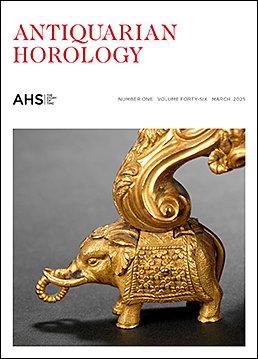Current issue of Antiquarian Horology

Volume 46, Issue 1, March 2025
On the front cover: Detail of a cabinet musical clock signed James Cox, London, dated 1766, formerly in the collection of King Farouk of Egypt. © Bonhams, London. The clock is illustrated full-page in Part 2 of Roger Smith’s article ‘James Cox: manufacturer and merchant’ published in this issue.
This issue contains the following articles:
James Cox: manufacturer and merchant – Part 2
by Roger Smith (pages 21-47)
Summary: Part 1 covered the background to Cox’s involvement in the export of clocks and watches to the ‘East Indies’. It also looked at the production of larger articles like clocks and automata in Cox’s own workshop and by his known collaborators. Part 2 considers the production of jewellery and other small articles by Cox, before discussing the more restricted mercantile role that he adopted towards the end of his career.
Lantern clock conversions – a technical survey
by John A Robey (pages 48-68)
Summary: Before 1658 all lantern clocks were made with a balance-controlled verge escapement, there being no practical alternative. However, their timekeeping was very poor, with both large day-to-day variations and long-term drifting. When the short pendulum and later, in the late 1660s, the long pendulum were introduced, few balance lantern clocks escaped being updated to pendulum control. At the same time most had their duration increased and often the two weights were changed to a single weight on a Huygens endless rope or chain. This article discusses these different conversions and the various alternative constructions employed. It looks at examples of clocks that illustrate some of the variety of combinations that are found.
Who invented the duplex escapement?
by Luigi Petrucci (pages 69-85)
Summary: The question of who invented the duplex escapement has been a matter of speculation for well over two centuries. This article tries to put the available information into order and into context, separating facts from hearsay, and highlighting potential misunderstandings. It also discusses two possible technical developments in which the duplex escapement came to be. (Read this article here)
Peter Medcalf (c. 1530–1592), turret clock maker
by Adrian A Finch, Valerie J Finch and Anthony W Finch (pages 86-99)
Summary: Peter Medcalf was a turret clock maker in Elizabethan London, free of the Clothworkers’ Company by Patrimony in 1565, and very likely the first free clockmaker within a London guild. Medcalf built and maintained turret clocks from a workshop in St Olave’s Southwark, supplying an expanding market in late Tudor England. He employed smiths from the metalworking regions of Eastern Flanders, one of the most advanced metalworking regions in Europe. Immigrant makers in his business trained English apprentices, thereby bringing expertise from the Low Countries to London. His workshop was dominant in late Tudor London and he may be the maker of unattributed turret clocks from the period. He is also the historical nexus point as we trace back the origins of many of the turret clockmaking community in Early Modern London.
‘Unfreezing Time #21’ by Patricia Fara (pages 100-102) (Read the whole series of articles here)
The issue totals 148 pages and is illustrated mainly in colour, and is completed by the regular sections Horological News, Unfreezing Time, Notes from the Librarian, AHS News, Letters and Further Reading.